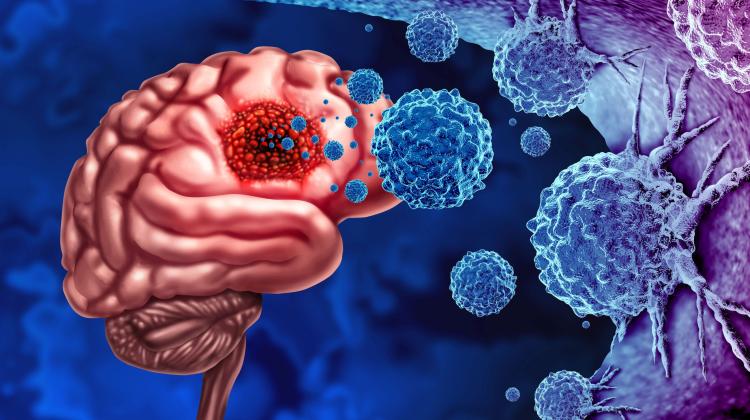Scientific work is for the persistent, says brain researcher
 Photo from L'Oréal press release
Photo from L'Oréal press release
‘There are successes in a scientist's work, but there are dozens of failures along the way. As much as 70-80 percent of our work ends in failure. However, a successful experiment is the greatest motivation for further work,’ says Dr. Aleksandra Rutkowska, who studies the nervous system, especially the degeneration processes taking place in the brain.
Dr. Rutkowska from the Brain Diseases Centre and the Department of Anatomy and Neurobiology at the Medical University of Gdańsk received a postdoctoral scholarship in the L'Oréal-UNESCO For Women and Science competition in 2023 and a scholarship for Outstanding Young Scientists awarded by the Ministry of Science and Higher Education.
She studies the mechanisms of damage to myelin sheaths in the brain and looks for ways to prevent and rebuild myelin damage, especially in the context of multiple sclerosis.
Myelin like an electric wire insulation
'The myelin sheath has a similar function to insulation in electrical wires. If a wire is insulated, electric charges do not escape from it. According to the same principle, in the brain, electrical impulses between neurons (the axons of which are surrounded by a myelin sheath) are transmitted quickly and efficiently. When this sheath, made of lipids and proteins, is destroyed, it is as if we had a wire with destroyed insulation. Not only the transmission of electrical impulses is much slower, but axons also degenerate and if the sheath is not rebuilt, neurons will die,’ says Dr. Rutkowska.
The myelin sheath is damaged in the course of chronic autoimmune demyelinating diseases, including multiple sclerosis, neurodegenerative diseases like Alzheimer's and Parkinson's, and as a consequence of sudden events such as stroke or viral infection. The loss of the myelin sheath causes a number of neurological symptoms: balance problems, cognitive disorders and impaired muscle function.
'The causes of demyelination are different in different diseases. In multiple sclerosis, our immune system cells attack myelin proteins because they recognize them as invaders. This is a whole cascade of events that leads to the death of oligodendrocytes, the central nervous system cells that build the myelin sheath,’ Rutkowska says.
In Alzheimer's or Parkinson's disease, she adds, researchers' knowledge of what happens to myelin sheaths is much smaller than in the case of multiple sclerosis. It is still unclear what comes first: whether the dysfunction of oligodendrocytes (forming the sheath) influences the development of these diseases, or whether their course causes the dysfunction of these cells.
Complicated myelin reconstruction pathways
Searching for therapies that stimulate the reconstruction of myelin sheaths, Dr. Rutkowska examines the functions of a number of receptors (proteins or molecules on the surface or in the cell that play a key role in communication within or between cells) that may be important in the process of myelin reconstruction.
Although therapies that modulate the course of multiple sclerosis are known and used, cell death still occurs. In some patients, myelin rebuilds efficiently, in others it does not. In addition, it will never be the same as the one that originally developed. And when someone experiences multiple relapses of the disease, over time myelin will completely cease to recover.
'In laboratory tests, we can, for example, remove myelin chemically, and check whether, using various molecules that activate a given receptor, it returns faster or more efficiently, or the opposite - it is inhibited. Using our laboratory models, we test methods that allow to regulate this process.
'When dealing with a new, potential therapeutic target, e.g. a receptor, we start research with the simplest models, i.e. commercially available cell lines. Then we move to primary cells that we isolate from mouse tissue and test molecules on them to learn about the processes that occur after activation of a given receptor with a molecule that activates it (called an agonist). We activate or block a given receptor and see how it affects the functioning of cells. In the case of oligodendrocytes, we are interested in the process of remyelination (reconstruction of the myelin sheath), whether we can accelerate or inhibit the differentiation of oligodendrocytes. There are many research paths, so-called therapeutic goals in this type of research,’ Rutkowska says.
Dr. Rutkowska currently has high hopes for the EBI2 receptor, which she has been researching since her doctoral dissertation. In the case of this receptor, advanced research is already being carried out on animals and human tissues collected from people with multiple sclerosis. The EBI2 receptor is found primarily on immune cells, such as B and T lymphocytes, and regulates the immune system response.
'Originally, my research focused on examining the immunological functions of this receptor in glial cells in the central nervous system. We found that myelination was delayed in mice genetically engineered to lack EBI2. This suggested that EBI2 could be important in the biology of oligodendrocytes and the structure of the myelin sheath,’ Rutkowska continues.
The results of Dr. Rutkowska’s thesis and subsequent studies on the function of the EBI2 receptor in oligodendrocytes and myelination have been published in the Journal of Neuroinflammation, European Journal of Neuroscience, and International Journal of Molecular Sciences.
'We are now testing a molecule that activates the EBI2 receptor to accelerate the process of rebuilding myelin after myelin removal in mice. The problem with it was that in its natural form it had a very short half-life of only half an hour. This means that half an hour after administration, only half of the administered amount remains in the body and the rest has been eliminated. Testing it would be pointless, but thanks to cooperation with chemists from the Gdańsk University of Technology, we managed to extend this time to 12 hours,’ the researcher says.
If preclinical studies are successful, scientists plan to move on to clinical trials.
'Unfortunately, this process is not only long, but also requires significant financial resources. Moreover, we believe in a realistic approach. Most substances that reach the clinical trial phase fail to achieve success despite promising preclinical results. The reasons for these failures can be found on both sides - both in preclinical research on animals and in clinical trials. Therefore, translational research is considered particularly demanding,’ says Rutkowska.
Scientist, prepare for a path full of failures
She adds that in the case of this type of research, it is important to realise that 70-80 percent of work ends in failure. When someone presents inspiring research results at a scientific conference, we often do not realise that these 50 minutes of presentation was preceded by 20 years of work.
'What motivates me is that sometimes something works out. The joy of that is enormous and incredibly motivating. So there are successes, but you have to know that there will be dozens of failures along the way. Experiments sometimes just don't work out. Then it is also worth remembering that even if you fail at something, you still contribute to the development of knowledge because someone else will no longer have to follow that path,’ the researcher admits.
Dr. Rutkowska is the winner of numerous grants, distinctions and awards for her scientific work. She has published over a dozen original research papers in top international journals, and the number of citations of her papers exceeds 300.
PAP - Science in Poland, Ewelina Krajczyńska-Wujec
ekr/ agt/ kap/
tr. RL
Przed dodaniem komentarza prosimy o zapoznanie z Regulaminem forum serwisu Nauka w Polsce.



















